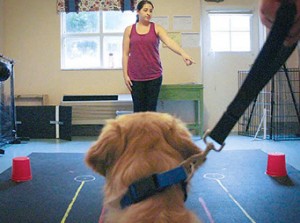Survival of the Friendliest? – Dog/Human Relationship
194 – July 2019
by Sue M. Copeland

In the bowels of Emory University’s psychology lab, Brian Hare’s frustration was mounting. It was the mid-1990s. For what seemed the thousandth time, the then 19-year-old anthropology student covered a morsel of food on the linoleum floor with an inverted Solo-type cup. Three feet away, he inverted a second cup without food; it would be the “dummy” cup.
Brian was helping renowned Developmental Psychologist Dr. Michael Tomasello study social cognition in primates, which would help the doctor learn more about human cognition – and what makes humans unique as a species. The cup test would gauge “gestural inference” in primates; also known as gestural communication. The ability to follow gestures, such as a pointed finger, is key to being human. In babies, it forms the basis of skills such as language.
A young chimpanzee was the current primate being humanely studied to answer one of Dr. Tomasello’s key questions, “Was gestural inference unique to humans?” Brian quietly brought the animal into the room. He silently pointed to the cup atop the food morsel. The chimp watched him intently, trying to determine what the young man wanted him to do. He slowly moved toward the cup without the food. Brian tried again, and again, as he had with previous primates in the study. Half the time the chimp would go to the dummy cup. The other half, he’d head toward the cup with food. As with other primates, this one’s random reactions told Brian that rather than following his pointed finger, the chimp was guessing which cup to go to. Finally, he walked the chimp back into its enclosure and trudged to Dr. Tomasello’s office to report the latest failure. “Ah,” mused the doctor after hearing Brian speak, “I think it’s becoming clear that only humans understand gestural inference.”
Click here to read the complete article194 – July 2019
Short URL: http://caninechronicle.com/?p=166698
Comments are closed











